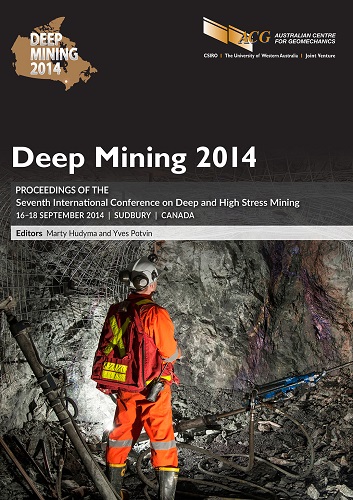Radon progeny in Ontario’s non-uranium underground mines

|
Authors: Dirige, APE Paper is not available for download Contact Us |
DOI https://doi.org/10.36487/ACG_rep/1410_55_Dirige
Cite As:
Dirige, APE 2014, 'Radon progeny in Ontario’s non-uranium underground mines', in M Hudyma & Y Potvin (eds), Deep Mining 2014: Proceedings of the Seventh International Conference on Deep and High Stress Mining, Australian Centre for Geomechanics, Perth, pp. 771-782, https://doi.org/10.36487/ACG_rep/1410_55_Dirige
Abstract:
Studies have linked long-term inhalation of radon progeny or radon daughters with adverse health effects such as lung cancer. Although the risk is very low when radon is diluted to extremely low concentrations in the open, radon in underground mines can accumulate up to dangerous concentrations and may cause substantial health damage after long-term exposure. Radon can be found in certain types of geology, such as granite and volcanic soils, as well as aluminous shales. Likewise, low concentrations of this gas can be expected in sedimentary rocks. In October 1988, Ontario’s Mining Legislative Review Committee (MLRC) approved regulation to control the higher levels of radon progeny found in some of the non-uranium mines. Several sections (287 to 293) were amended to Regulation 854 (Ministry of Labour 2012). In sections 287 to 293, ‘radon daughters’ means polonium-218 (RaA), lead-214 (RaB), bismuth-214 (RaC) and polonium-214 (RaC’). The unit of radon daughter concentration is expressed in working level (WL) or working level month (WLM). The maximum allowable exposure each month for one year to maintain annual exposures below 1 WLM is 0.083 WL and the ceiling concentration is 0.33 WL. Section 289 describes air sampling protocols for radon daughters. This paper presents the results of radon assessments conducted from 2004-2012 at various locations in 28 Ontario’s non-uranium underground mines. A total of 325 measurements were conducted and results indicated that radon progeny concentrations measured ranged from 0.000-0.070 WL. These were all below the maximum allowable exposure each month for one year of 0.083 WL to maintain annual exposure of 1 WLM; 97% of the measurements were within 0.000-0.030 WL, 2% were within 0.031-0.060 WL, and 1% was within 0.061-0.10 (or 0.070) WL. At these concentrations, actions that have to be conducted by the non-uranium underground mines range from annual assessment by a competent person (<0.03 WL), annual sampling of workplaces (0.031-0.06 WL), and quarterly sampling of workplaces (0.061-0.10 WL). Maintaining good ventilation in Ontario’s non-uranium underground mines may have contributed to the generally low radon progeny concentration levels measured from 2004-2012.
References:
Ann, ICRP 1968, ‘Evaluation of Radiation Doses to Body Tissues from Internal Contamination due to Occupational Exposure’, Annals of the ICRP Report of Committee IV, January 1968.
Canadian Nuclear Safety Commission 2003, Measuring Airborne Radon Progeny at Uranium Mines and Mills, Regulatory Guide G-4, Canadian Nuclear Safety Commission, Ottawa.
Kusnetz, HL 1956, ‘Radon Daughters in Mine Atmospheres – A field Method for Determining Concentrations’, Industrial Hygiene Quarterly, vol. 17.
Ministry of Labour 2005a, Health & Safety Guideline Regulation 854/90 Section 287 & 288: Radon Progeny – Sampling, Ministry of Labour, Toronto.
Ministry of Labour 2005b, Health & Safety Guideline Regulation 854/90 Section 289: Radon Progeny – Definitions and Applications, Ministry of Labour, Toronto.
Ministry of Labour 2005c, Health & Safety Guideline Regulation 854/90 Section 292: Radon Progeny – Written Work Practices, Ministry of Labour, Toronto.
Ministry of Labour 2012, R.R.O. 1990, Regulation 854 – Mine and Mining Plants, Last Amendment - January 1, 2012, Ministry of Labour, Toronto.
Müller, J, Gentleman, JF, Wheeler, W, Suranyi, G, Holden, B, Elaguppillai, V & Kusiak, R 1986, Study of Mortality of Ontario Gold Miners 1955-1977, Ontario Ministry of Labour, Toronto.
United Nations Scientific Committee on the Effects of Atomic Radiation 2000, Sources and effects of ionizing radiation, UNSCEAR 2000 Report to the General Assembly Report to the United Nations General Assembly, United Nations, New York
World Health Organization 2004, Information Sheet March 2004 – Radon and Health, World Health Organization, viewed 1 August,
© Copyright 2025, Australian Centre for Geomechanics (ACG), The University of Western Australia. All rights reserved.
View copyright/legal information
Please direct any queries or error reports to repository-acg@uwa.edu.au
View copyright/legal information
Please direct any queries or error reports to repository-acg@uwa.edu.au